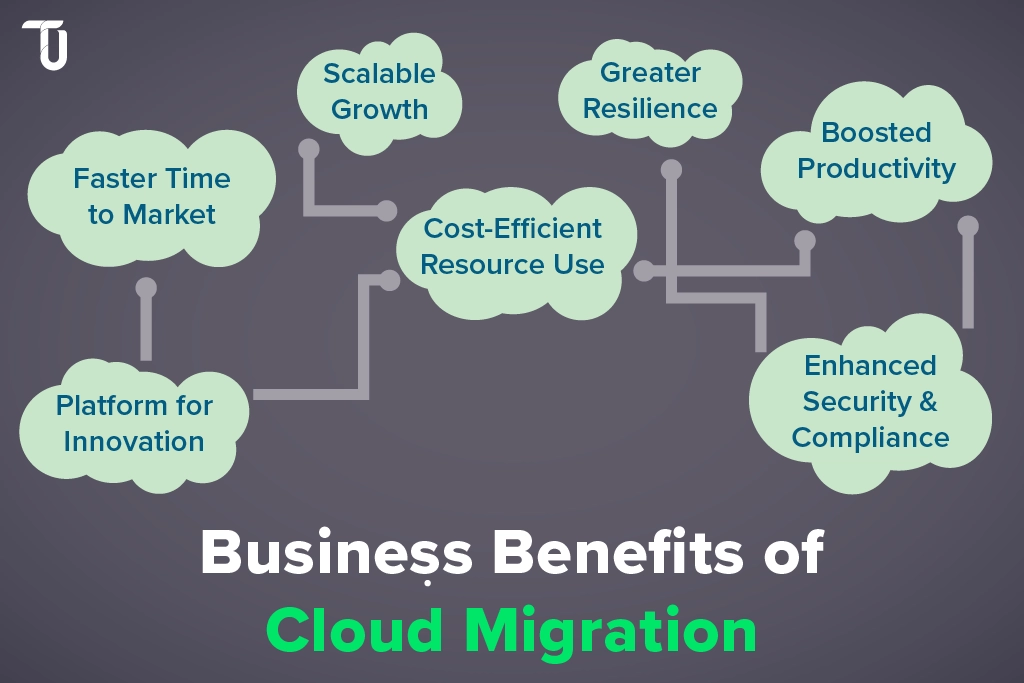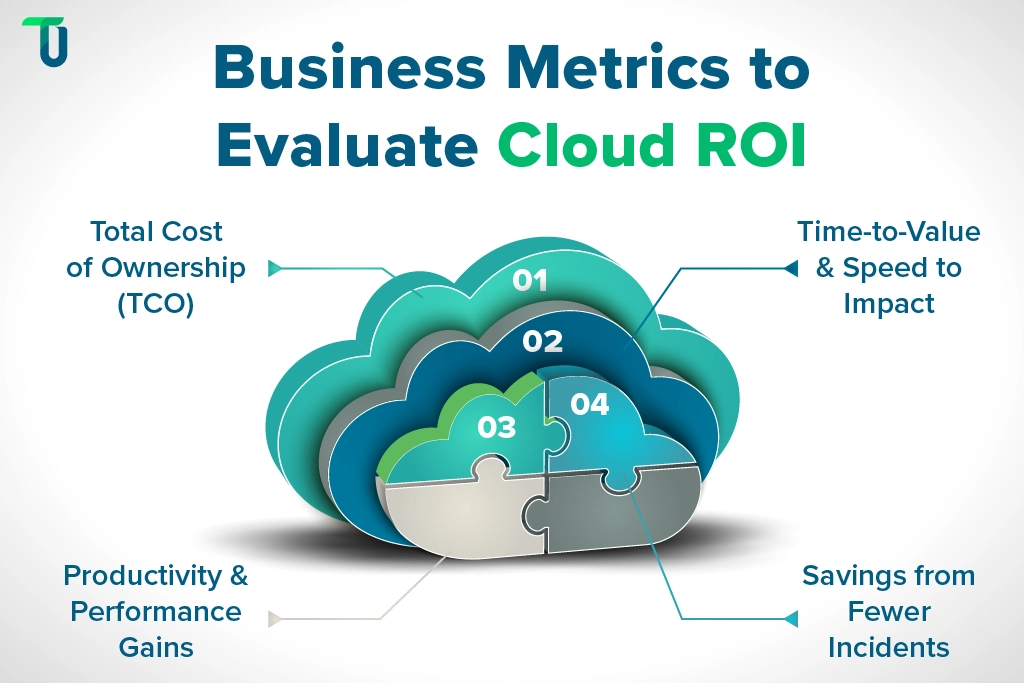Breaking Down the True Costs of Cloud Adoption
Cloud promises scalability, flexibility, and speed—but those benefits come with a price tag that’s often more layered than expected. That’s why many early-stage businesses turn to cloud application development services for startups to balance agility with cost efficiency right from the start. For the C-suite, understanding the full spectrum of cloud costs is critical to setting realistic budgets and driving ROI for cloud cost optimization.
Direct Costs: The Visible Line Items
These are the upfront, budgeted Cloud expenses you anticipate:
- Subscription and Licensing Fees for IaaS, PaaS, and SaaS models
- Migration and Re-platforming Costs, including third-party tools or partner support
- Infrastructure Costs based on compute, storage, and network usage
While easy to quantify, direct costs only tell part of the story.
Indirect Costs: The Operational Ripple Effects
Cloud transformation often reshapes internal processes, skills, and timelines.
- Employee Training and Upskilling to manage new environments
- Process Redesigns across DevOps, ITSM, and security operations—including how to navigate the trade-offs in control and compliance when weighing public versus private setups—are detailed in our analysis of public vs private cloud security differences .
- Downtime or Business Disruption during migration phases
These costs affect productivity and project velocity—often overlooked during initial planning.
Hidden Costs: The Long-Tail Financial Commitments
What isn’t on the invoice might impact your long-term cloud ROI:
- Vendor Lock-in that restricts flexibility and increases switching costs
- Compliance and Governance demands that require ongoing oversight For a deeper dive on how different environments compare in terms of control and risk, see our discussion on public vs private cloud security differences.
- Security Enhancements to mitigate risks in multi-cloud or hybrid setups
Understanding these hidden costs upfront helps you avoid budget surprises and ensures alignment with long-term business goals.
Key Business Benefits of Moving to the Cloud
The shift to cloud isn’t just a tactical IT move—it’s a strategic growth enabler. For C-level leaders, the question is no longer whether to move to the cloud, but how to unlock its full business value. Here’s a breakdown of the core benefits cloud delivers, when aligned with the right strategy and execution.

Accelerated Time to Market
Speed is currency in today’s market. Cloud platforms empower organizations to launch new products, features, or digital services faster, without the typical infrastructure delays.
How?
- Pre-configured development environments.
- Infrastructure-as-Code (IaC) for rapid provisioning.
- CI/CD pipelines for faster iterations.
Katalon, a quality management platform, modernized its infrastructure using AWS Lambda and Amazon MSK. This shift allowed them to accommodate variable workloads and over 30,000 customers, resulting in an improved time to market for their clients.
Scalability That Matches Business Growth
Whether you’re scaling to meet seasonal demand or expanding to new geographies, cloud allows your infrastructure to grow (or shrink) with your business—without upfront capital expense.
How?
- Auto-scaling capabilities
- Global data center availability
- Load balancing across geographies
Toyota Connected leveraged AWS serverless architecture to build its Toyota Mobility Services Platform. This enabled them to seamlessly scale to 18 times their usual traffic volume, handling 18 billion transactions per month while reducing aggregation job times significantly.
Increased Resilience and Business Continuity
Cloud platforms offer built-in disaster recovery, backup, and multi-region deployment—ensuring your business stays up and running with strong cloud resilience for enterprise ERPs, even when local systems fail.
How?
- Multi-AZ (Availability Zone) redundancy
- Automated failover and backups
- Real-time data replication
SGK, a marketing agency, adopted AWS serverless architectures, which allowed them to reduce IT infrastructure costs by 83% and deployment times by 96%. This transition enhanced their ability to deliver services reliably to a global audience.
Improved Collaboration and Workforce Productivity
With remote and hybrid work becoming the norm, cloud-based tools enable seamless collaboration across teams, time zones, and devices.
How?
- Real-time document editing
- Centralized access to data and tools
- Cloud-based communication platforms
Cost Optimization Through Elastic Resource Usage
Cloud reduces the burden of upfront infrastructure investments. But more importantly, it enables organizations to only pay for what they use—and to continuously optimize that usage.
How?
- Pay-as-you-go and reserved instance models
- Serverless computing (pay only per execution)
- Cost visibility through monitoring and tagging
Stronger Security Posture with Built-In Compliance
Top cloud providers invest billions into security infrastructure, tools, and certifications—giving businesses enterprise-grade protection without building it from scratch.
How?
- Identity and Access Management (IAM)
- Threat detection and security monitoring
- Built-in compliance (e.g., HIPAA, GDPR, SOC 2)
Ambra Health uses Google's Data Loss Prevention (DLP) tool to de-identify medical data, ensuring compliance with HIPAA regulations and enhancing patient data privacy.
A Foundation for Innovation and New Business Models
Cloud is not just infrastructure—it’s a platform for innovation. With access to AI, ML, IoT, and big data services, businesses can create entirely new products and revenue streams.
How?
- Plug-and-play AI/ML APIs
- Data lakes and real-time analytics
- API gateways for platform business models
Not seeing the ROI you expected from cloud migration?
Move beyond lift-and-shift—unlock real business value with a smarter cloud strategy. Talk to our experts today.
Cloud vs. On-Premises: A Financial and Operational Comparison
For C-level leaders, understanding the financial and operational trade-offs between cloud and on-premises infrastructure is critical to making high-impact, future-ready investments. Let’s break it down:
CAPEX vs. OPEX: Changing the IT Spend Model
On-Premises: Owning infrastructure means upfront capital expenditure (CAPEX). From hardware procurement and data center setup to long-term maintenance contracts, you’re locked into multi-year investments—regardless of business demand.
Cloud: The cloud flips this model into an operational expenditure (OPEX) structure. You pay for compute, storage, and bandwidth as you use them. This unlocks financial flexibility, enabling IT to scale with business needs instead of working within static budget cycles.
Why It Matters to the C-Suite:
- Frees up capital for innovation, M&A, or customer experience initiatives.
- Aligns tech spending with revenue-generating activity.
- Reduces sunk costs and shortens investment cycles.
Maintenance, Resource Focus, and Business Agility
On-Premises: IT teams spend significant time on infrastructure upkeep—patching, upgrading, monitoring, troubleshooting. These routine tasks drain engineering bandwidth that could be redirected toward innovation.
Cloud: Cloud providers take care of maintenance, updates, and uptime guarantees. Internal teams can shift focus from managing systems to driving outcomes—like building new products, improving CX, or automating operations.
Why It Matters to the C-Suite:
- Accelerates digital initiatives
- Frees up top engineering talent for core business priorities
- Enhances the organization's ability to respond to change
Resilience, Availability, and Disaster Recovery Costs
On-Premises: Building a highly available infrastructure requires redundant systems, backup sites, and complex disaster recovery setups—each adding cost and complexity. Scaling this resilience globally is a massive undertaking.
Cloud: Cloud-native architectures offer resilience by design—across availability zones, regions, and continents. Features like automated failover, geo-replication, and built-in DR tools reduce both the risk and the cost of downtime.
Why It Matters to the C-Suite:
- Avoids business disruption and loss of revenue during outages
- Strengthens compliance and uptime SLAs
- Reduces the total cost of maintaining high availability
Netflix leverages AWS's global infrastructure for resilience and disaster recovery. They’ve architected their systems to remain operational even when entire regions go down, ensuring zero interruption in global streaming services.
Evaluating Cloud ROI: Metrics C-Suite Leaders Must Track
Cloud success isn’t just about uptime—it’s about measurable business value. For the C-suite, tracking the right metrics turns cloud conversations from speculative to strategic. Here are the four pillars of ROI that matter most:

Total Cost of Ownership (TCO) Over Time
Move beyond upfront costs. A true TCO assessment should factor in infrastructure, personnel, licensing, support, and energy costs—across a 3-5 year horizon.
Why it matters: It helps compare apples to apples between cloud vs. on-prem and makes budgeting future-proof.
Time-to-Value (TTV) and Business Acceleration
How quickly does a cloud investment start delivering outcomes—be it product launches, automation, or faster CX improvements?
Why it matters: Shorter TTV means faster competitive advantage and quicker payback on investment.
Productivity Gains and Performance Metrics
Track developer throughput, deployment frequency, and time saved on maintenance tasks. Cloud unlocks efficiency—quantify it.
Why it matters: Efficiency improvements directly influence operational ROI and team satisfaction.
Cost Savings from Incident Reduction and Resilience
Fewer outages. Faster recovery. Lower downtime costs. Measure the drop in SLA violations, support tickets, and security incidents post-cloud adoption.
Why it matters: Every avoided incident is cost saved and trust earned.
Strategic Cloud Cost Management Priorities for C-Suite Decision-Makers
Cloud investments that don’t map to business strategy are just sunk costs in disguise. To lead with impact, the C-suite must prioritize initiatives that tie technology to outcomes. Here are the top focus areas that demand leadership attention: To see how cloud consulting accelerates DevOps and improves cost efficiency, explore our in-depth guide on combining DevOps with cloud consulting.
Aligning Cloud Investments with Business Objectives
Every cloud initiative must serve a clear business goal—be it entering a new market, accelerating product delivery, or enhancing customer experience.
Action Point: Tie cloud KPIs directly to strategic objectives like revenue growth, margin improvement, or time-to-market acceleration.
Crafting a Governance Framework for Cloud Success
Without governance, cloud sprawl is inevitable. The right framework ensures visibility, security, and compliance—without stifling innovation.
Action Point: Establish clear ownership models, cost controls, and policy enforcement across cloud environments.
Navigating Multi-Cloud and Hybrid Cloud Complexities
As enterprises grow, multi-cloud and hybrid setups are the norm, not the exception. But with flexibility comes complexity.
Action Point: Invest in orchestration, centralized monitoring, and cross-cloud policy alignment to avoid silos and reduce operational overhead.
Common Pitfalls in Cloud Cost-Benefit Analysis (And How to Avoid Them)
The cloud promises agility, efficiency, and speed—but only when the investment is evaluated through a strategic, long-term lens. Too often, cost-benefit analyses focus on short-term savings while overlooking deeper business and operational implications. Here are three high-impact missteps to avoid:
Underestimating Change Management and Integration Complexity
It’s easy to calculate infrastructure costs. What’s harder—and often missed—is the real impact of organizational change. Cloud adoption reshapes workflows, roles, and interdependencies across departments. Migrations often stall not because of tech, but because teams aren’t aligned or trained.
Avoid this by:
- Budgeting for reskilling, onboarding, and stakeholder alignment
- Building a communication and adoption roadmap before the migration
- Considering the integration cost of legacy systems and third-party tools
C-level takeaway: Cloud transformation is 30% technology, 70% people and process. Don’t let poor change management eat into your ROI.
Overlooking Long-Term Scalability and Flexibility Needs
Many organizations plan for immediate lift-and-shift but fail to consider how the solution will scale as the business grows. This short-term thinking leads to costly re-architecture later—and limits agility when expansion demands speed.
Avoid this by:
- Choosing modular, cloud-native architectures that scale horizontally — for a deeper understanding of how to design scalable, future-ready systems, check out our scalable cloud app development guide.
- Forecasting usage growth over 3–5 years, not just the first 12 months
- Asking: “Will this architecture support new markets, M&A, or innovation two years from now?”
C-level takeaway: Cloud investments should support your future-state business—not just today’s problem
Ignoring Vendor SLAs, Exit Strategies, and Future-Proofing
Many cloud contracts look great at first glance—until you hit scale, hit a snag, or need to pivot. You're locked into one provider’s pricing, tooling, and limitations without a well-defined exit strategy. That’s a long-term risk most execs can’t afford.
Avoid this by:
- Reviewing SLAs for availability, performance, and penalties
- Building data portability and multi-cloud readiness into your architecture
- Planning for exit costs, transition timelines, and contingency options up front
C-level takeaway: Flexibility is the new currency of resilience. Design for portability before you need it.
Don’t Just Migrate to the Cloud—Modernize with Impact
The cloud isn’t just a line item in your IT budget—it’s a lever for business acceleration. But without a clear cloud cost optimization strategy , the right metrics, and a future-ready foundation, it’s easy to get stuck in cost overruns, complexity, and missed expectations. That’s where TenUp Software Services steps in—not just as a tech vendor, but as your cloud growth partner.
From cloud-native builds and modernization to migration, governance, and cost optimization, TenUp’s result-driven cloud solution services help C-suite leaders connect cloud investments to bottom-line results. Whether you're replatforming legacy apps or scaling across multi-cloud environments, our expert brings the clarity, speed, and technical depth to turn your cloud vision into a business reality. Ready to transform the cloud from a cost center to a growth engine? Partner with TenUp—and build a cloud strategy to scale, secure, and succeed.
Struggling to turn cloud goals into real business outcomes?
Our cloud experts help you convert strategy into measurable ROI—boost performance, reduce costs, and scale with confidence.
Frequently asked questions
What are the most common mistakes organizations make in cloud cost optimization?
Common mistakes include overprovisioning resources, not leveraging Reserved Instances or Savings Plans, failing to monitor usage, poor tagging practices, and ignoring data transfer costs. These lead to overspending and missed optimization opportunities.
How can we effectively monitor and manage cloud costs across multiple teams or departments?
Implementing dashboards that display cloud costs by team or department and sharing them regularly can promote accountability and cost awareness. Tools like Azure Cost Management allow organizations to track costs across business units, environments, or projects, providing visibility and control over cloud expenditures.
What are the best practices for rightsizing cloud resources?
Rightsizing involves continuously monitoring usage and aligning instance types and sizes with actual workload demands. Key practices include analyzing performance metrics, eliminating idle resources, using auto-scaling, and adjusting capacities to prevent over- or under-provisioning—maximizing efficiency and minimizing costs.
How can we leverage Reserved Instances and Savings Plans to reduce costs?
Reserved Instances and Savings Plans cut costs by offering up to 72% off in exchange for usage commitments. Use RIs for predictable workloads and Savings Plans for flexible compute needs. Analyzing usage patterns and combining both options ensures maximum cost efficiency.
What tools are available for cloud cost optimization, and how do they compare?
Top tools include AWS Cost Explorer, Azure Cost Management, and Google Cloud Billing for native insights, while third-party platforms like CloudZero, CloudHealth, and Spot.io offer deeper analytics, automation, and multi-cloud support. Choose based on cloud complexity, budget, and desired level of cost control.
What strategies can help in managing cloud costs during periods of rapid growth or scaling?
To manage costs during rapid growth, use auto-scaling, reserve instances for predictable workloads, and continuously monitor usage. Leverage cloud cost tools for visibility, eliminate idle resources, and right-size infrastructure to align capacity with demand.
What role does automation play in cloud cost optimization?
Automation reduces cloud costs by auto-scaling resources, shutting down idle services, and detecting anomalies in real time. It enhances efficiency, minimizes manual errors, and ensures resources are always aligned with actual usage.

